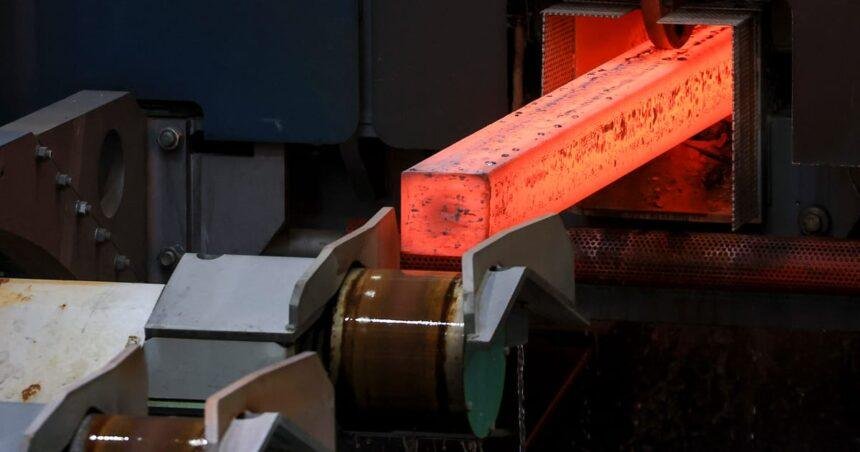EU Proposes 50% Steel Tariff in Response to Global Overcapacity
In a significant move aimed at addressing the ongoing global steel overcapacity crisis, the European Union (EU) has announced plans to implement a 50% tariff on steel imports. This proposal, which aligns with similar measures taken by Canada, is seen as a strategic step towards negotiating a more favorable trade relationship with the United States. The announcement comes amid growing concerns about the imbalance between steel production and consumption worldwide.
Global Steel Overcapacity: A Persistent Challenge
The global steel industry is currently grappling with a surplus of production capacity, with estimates indicating that the total output from steel plants worldwide exceeds consumption by a substantial margin. According to industry reports, global steel production capacity is approximately five times greater than the demand within Europe. This overcapacity not only threatens the economic stability of steel-producing nations but also poses challenges for environmental sustainability, as excess production often leads to increased emissions and resource depletion.
EU’s Strategic Positioning
The EU’s proposed 50% tariff is designed to protect its domestic steel industry while fostering a collaborative approach to tackling global overcapacity. A senior official from the European Commission, who spoke on the condition of anonymity, emphasized the need for a global solution to this pressing issue. “We have a global problem, so this requires really a global solution that has to touch on everybody,” the official stated.
This tariff proposal is particularly noteworthy as it seeks to create a foundation for future negotiations with the United States. The EU’s approach is more measured compared to the 50% tariff imposed by former President Donald Trump, which applies to virtually all steel imports from the first ton. The EU’s strategy aims to balance protection for its domestic industry while avoiding a trade war that could escalate tensions between the two economic powerhouses.
A Stepping Stone Towards Cooperation
The EU’s initiative is viewed as a “stepping stone” towards a more comprehensive agreement with the U.S. In July, both parties acknowledged the need for collaboration in addressing the challenges posed by global steel overcapacity. Maroš Šefčovič, a senior EU official, highlighted the modest scale of transatlantic steel trade, suggesting that the EU and the U.S. are natural allies in this endeavor. “We are taking on the challenge of global overcapacity ourselves, and it would be much more efficient if we did it together, or with like-minded partners,” he remarked.
The EU’s proposed tariff is expected to serve as a basis for engaging in negotiations with the U.S. The official noted that the bloc hopes this initiative will create an “opening” for discussions aimed at reducing the current tariffs that affect EU steel exports to the U.S. This collaborative approach reflects a broader trend in international trade, where countries are increasingly recognizing the importance of working together to address shared challenges.
Historical Context and Comparisons
The current situation in the steel industry is reminiscent of past trade disputes, particularly during the early 2000s when the U.S. imposed tariffs on steel imports under President George W. Bush. That move sparked retaliatory measures from various countries and led to a protracted trade conflict. The lessons learned from those events underscore the importance of diplomacy and cooperation in resolving trade issues.
In contrast to the unilateral approach taken by the U.S. in the past, the EU’s strategy emphasizes multilateral engagement. By aligning its tariff proposal with Canada’s measures, the EU is signaling its commitment to a coordinated response to global overcapacity. This approach not only strengthens the EU’s position in negotiations with the U.S. but also fosters solidarity among like-minded nations facing similar challenges.
Implications for the Global Steel Market
The proposed 50% tariff is likely to have far-reaching implications for the global steel market. As countries grapple with the consequences of overcapacity, the EU’s initiative may prompt other nations to reconsider their own trade policies. The potential for a ripple effect in the global steel industry could lead to increased scrutiny of production practices and a renewed focus on sustainability.
Moreover, the EU’s move may encourage other regions to adopt similar protective measures, further complicating the landscape of international trade. As countries prioritize their domestic industries, the risk of escalating trade tensions looms large. The EU’s approach, however, seeks to mitigate these risks by fostering dialogue and cooperation with key trading partners.
Conclusion
The European Union’s proposal to implement a 50% tariff on steel imports marks a significant step in addressing the global overcapacity crisis. By positioning itself as a collaborative partner in negotiations with the United States, the EU aims to create a more balanced and sustainable steel market. As the world grapples with the challenges of overproduction, the importance of international cooperation cannot be overstated. The EU’s initiative serves as a reminder that addressing global issues requires collective action and a commitment to finding mutually beneficial solutions.










